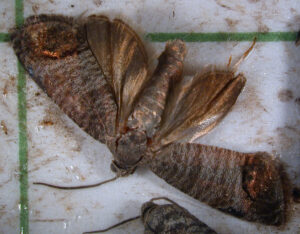Depending on where you are in the state, your fruit trees may be nearing the end of petal fall or already beginning fruit set! This is an important time to pay close attention to your pheromone-baited monitoring traps for captures of codling moth (Figure 1) that you are all likely familiar with. You’ve likely already captured adult moths in your traps at this point in the season; here at our fruit research orchard in Lafayette, we’ve captured codling moths on and off in pheromone-baited traps since May 14, 2022, with the highest number of captures in a day reaching 6 moths (https://extension.entm.purdue.edu/longlab/extension/#reports). With that being said, activity in the traps has been a little unusual this year with the cooler temperatures we’ve seen this spring, such that we haven’t seen consistent captures of more than 1 moth. However, for those of you who have seen consistent captures of 3-5 moths in your baited traps, you’ve likely reached biofix: the date when pheromone traps detect sustained flight of moths. After this date, you should begin to calculating cumulative degree days to time your first and second cover sprays for this pest. In the case of codling moth, begin tracking cumulative degree days and apply insecticides 50-250 degree days after trap-based biofix. As with many insect pests in the orchard, proper timing of insecticide application is key! The closer you can get to optimal timing, the better management of the pest will be. For those with history of plum curculio in the orchard that were unable to apply an insecticide at petal fall, you might also consider applying an insecticide that manages both codling moth and plum curclio for your first cover spray.
You can find more information about timing of first codling moth sprays and insecticide options on page 34 of the 2021-2022 Midwest Fruit Pest Management Guide. For best management, it is recommended that the first spray be followed by a second spray 10-14 days later. As always, if you have questions, reach out to your local extension educator or specialist so we can help!
